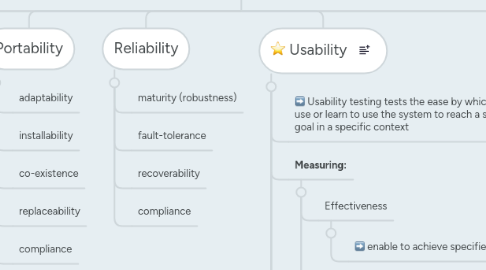
1. Functionality
1.1. Accuracy
1.1.1. Any Stage of Lifecycle
1.1.2. Functional accuracy involves testing the application's adherence to the specified or implied requirements and may also include computational accuracy.
1.1.3. targeted on incorrect handling of data or situations
1.2. suitability
1.2.1. Defects discovered=>system will not be able to meet the needs of the user
1.2.2. Suitability testing involves evaluating and validating the appropriateness of a set of functions for its intended specified tasks.
1.2.3. can be based on use cases
1.2.4. Lifecycle
1.2.4.1. system testing
1.2.4.2. later stages of integration testing
1.3. interoperability
1.3.1. Lifecycle
1.3.1.1. component integration testing
1.3.1.2. system testing
1.3.1.2.1. determine how well the fully developed system interacts with other systems
1.3.2. Techniques
1.3.2.1. decision tables
1.3.2.2. state transition diagrams
1.3.2.3. use cases
1.3.2.4. combinatorial testing
1.3.3. Typical defects
1.3.3.1. incorrect data exchange between interacting components
1.3.4. how software systems interact with each other?
1.3.5. Testing must cover all the intended target environments
1.3.6. focus
1.3.6.1. Usage of industry-wide communications standards
1.3.6.2. Is system adjust accordingly to the communications needs of the systems it interacts with?
1.4. compliance
1.5. Security
2. Maintainability
2.1. analyzability
2.2. changeability
2.3. stability
2.4. testability
2.5. compliance
3. Portability
3.1. adaptability
3.2. installability
3.3. co-existence
3.4. replaceability
3.5. compliance
4. Reliability
4.1. maturity (robustness)
4.2. fault-tolerance
4.3. recoverability
4.4. compliance
5. Usability
5.1. Usability testing tests the ease by which users can use or learn to use the system to reach a specified goal in a specific context
5.2. Measuring:
5.2.1. Effectiveness
5.2.1.1. enable to achieve specified goals
5.2.2. Efficiency
5.2.3. Satisfaction
5.3. Sub-Characteristics
5.3.1. learnability
5.3.2. operability
5.3.3. attractiveness
5.3.4. compliance
5.3.5. Accessibility
5.3.5.1. the accessibility to software for those with particular needs or restrictions
5.3.5.2. Consider the relevant standards
5.3.5.2.1. Web Content Accessibility Guidelines
5.3.5.2.2. Disability Discrimination Acts
5.3.6. Understandability
5.4. Testing Steps
5.4.1. Formative Usability Testing
5.4.1.1. conducted iteratively during the design and prototyping stages to help guide (or "form")
5.4.2. Summative Usability Testing
5.4.2.1. conducted after implementation to measure the usability
5.5. Tester Skills
5.5.1. Sociology
5.5.2. Psychology
5.5.3. Conformance to national standards (including accessibility standards)
5.5.4. Ergonomics
5.6. Conducting surveys and questionnaires
5.6.1. SUMI (Software Usability Measurement Inventory)
5.6.2. WAMMI (Website Analysis and MeasureMent Inventory)
